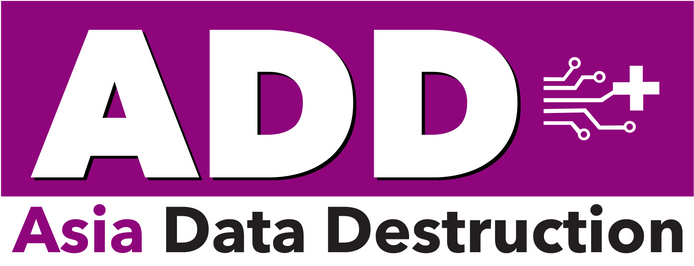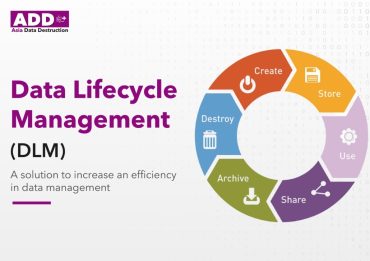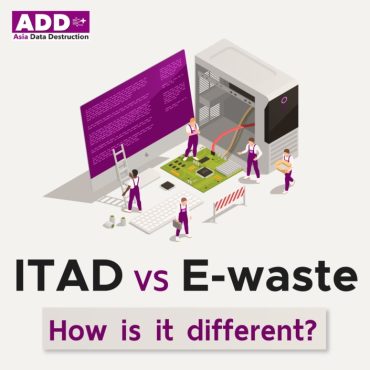
Data destruction is a very important business process to maintain confidentiality and prevent risks from data leaks. In an era where technology plays an important role in business operations. Data is very valuable and protecting its confidentiality has become an important concern. Therefore, data destruction is not only a legal process. But it’s also about taking action to preserve business and customers.
Here are 5 reasons why data destruction is a huge business priority.
Table of Contents
- 1. Prevent information leakage
- 2. Maintain confidentiality and trustworthiness
- 3. Comply with the law and maintain data integrity
- 4. Prevent business risks
- 5. Coordination with the law
- Summary of content
1. Prevent information leakage
Data leaks can cause businesses to lose the trust of customers and partners. Leaked information can affect an organization’s image and can lead to financial losses. reliability and being a business Data destruction reduces the risk of data leakage.
Preventing data leaks is an important measure that organizations should incorporate into their business processes. This is a method that can be used to prevent information leakage.
Creating a confidentiality policy:
- Set a clear policy: Create a clear policy that addresses the confidentiality of the data your organization maintains. The policy should cover customer information, internal information, and sensitive information.
- Employee Training: Train employees to understand and follow confidentiality policies. Make employees understand the importance of protecting information confidentiality.
Use of anti-leakage technology:
- Use of Encryption: Encryption technology is used to protect stored data. Using Encryption reduces the risk in case of data leakage.
- Malware Detection and Protection: Use anti-virus and anti-malware programs to prevent potentially compromised programs from entering the system.
- Firewalls and Intrusion Detection Systems (IDS): Use Firewalls and IDS to control access and detect potential intrusions.
Data access management:
- Assigning access rights: Assign individual access rights to data based on location and needs. Permissions are limited to reduce the risk of leaks.
- Access Audit: Track and record access to data. Access auditing helps in detecting inappropriate activities.
Data Destruction of unnecessary :
- Regular data destruction: Destroy unnecessary data after use. Unused data should not be stored in the system.
- Destruction of Hard Drives and Media: Use safe methods to destroy your hard drive or media.
Preventing data leaks is a process that must be taken seriously at all times. Clear policies, protection technologies, data access management, and destruction of unnecessary data are some of the measures that can help reduce the risk of data leaks.
2. Maintain confidentiality and trustworthiness
Maintaining the confidentiality of information is important in building trust with customers and partners. Destroying unnecessary data after use ensures that it is not stored unnecessarily and has no chance of being used inappropriately.
Confidentiality and trust are important factors affecting an organization’s image and success. Here are some methods that can be used to maintain confidentiality and trust in business:
Creating a confidentiality policy:
- Set a clear policy: Create a clear policy regarding data confidentiality. This policy should cover all levels of data that the organization maintains.
- Meetings and Communications: Communicate policies and values regarding confidentiality in the organization. Conferences and seminars are a great opportunity to communicate the importance of confidentiality.
Employee training:
- Confidentiality Training: Let employees know the importance of confidentiality. Training helps employees understand policies and participate in maintaining confidentiality.
- Comprehension Test: Conduct a confidentiality policy comprehension test to test that employees understand and follow the policy correctly.
Use of confidentiality technology:
- Use of Encryption: Use encryption technology to protect sensitive information. Using encryption reduces the risk in the event of data leaks.
- Malware Detection and Protection: Use anti-virus and anti-malware programs to prevent potentially compromised programs from entering the system.
External inspection and protection:
- Third Party Audits: Conduct regular audits of third parties with access to data. Audits help identify confidentiality risks.
- Access Control: Implement access control measures to prevent unauthorized outsiders from accessing the data.
Risk identification and management:
- Risk Identification: Analyze and identify risks related to data confidentiality.
- Risk Management: Develop a risk management plan related to confidentiality. Have a clear contingency plan and process for when a breach occurs.
Confidentiality and trust are processes that must be mastered at all levels of the organization. Creating easy-to-understand policies, training staff, using appropriate technology, ensuring understanding, external auditing and protection, and identifying and managing risks, will help organizations maintain confidentiality and Effective reliability
3. Comply with the law and maintain data integrity
The destruction of unnecessary data is in compliance with laws related to maintaining data integrity. Maintaining data integrity in business systems strengthens organizations’ trust in the market.
Complying with the law and maintaining data integrity is an essential part of achieving trustworthiness and protecting data security. Here are some methods that can be used to comply with the law and maintain data integrity:
Understanding and following the law:
- Knowing the relevant laws: Understand the laws related to maintaining data integrity, both local and international.
- Liaising with the legal team: Liaising with the legal team to advise on legal compliance and data integrity.
Maintaining data integrity:
- Backup: Regular backups are made to protect data from loss or damage.
- Assigning access rights: Assigning individual access rights to data based on their location and needs.
Prevention of information leakage:
- Use of Encryption: Use encryption technology to protect sensitive information.
- Malware Detection and Protection: Use anti-virus and anti-malware programs to prevent potentially compromised programs from entering the system.
Destruction of unnecessary data:
- Proper data destruction: Use secure data destruction methods to destroy unnecessary data.
- Destruction of Hard Drives and Media: Use safe methods to destroy your hard drive or media.
Inspections and improvements:
- Audits and Assessments: Regularly audit data integrity systems and assess risks.
- Improving policies and procedures: Update policies and procedures according to the speed of technology and legal changes.
Compliance with laws and maintaining data integrity are essential to helping organizations protect data security and integrity within their business processes. Audits, assessments, and updates as needed help organizations maintain data stewardship. efficiently
4. Prevent business risks
Destroying unnecessary data reduces business risks associated with data leaks. Customers’ sense of protecting the confidentiality of their data makes an organization stable and reliable in business.
Business hedging is an important process for maintaining the stability and reliability of a business. Here are some methods that can be used to hedge business risks:
Risk identification and analysis:
- Risk Identification: Identify and document possible internal and external risks of the organization.
- Risk Analysis: Conduct a risk analysis to understand the impact and severity of the risk.
Creating a Risk Management Plan:
- Defining a management plan: Create a risk management plan that includes preventative, contingency, and project measures.
- Management plan testing: Test the management plan to check its technical and organizational readiness.
Partner Risk Assessment:
- Risk Assessment: Assess the risks of partners and service providers involved in the business.
- Data Validation: Review and identify potential risks from observed data.
Safe use of technology:
- Use of protection technology: Use protection technology such as antivirus, intrusion detection, and data encryption.
- Promoting data security: Create measures to promote data security at all levels of the organization.
Training and Risk Understanding:
- Employee Training: Train employees to understand and be aware of potential risks.
- Information Sharing: Share information about business risks within teams and at the enterprise level.
Business risk prevention is a continuous process. Analysis, creating management plans, evaluating partners, using secure technology, training, and sharing information are some of the measures that reduce business risk.
5. Coordination with the law
The destruction of unnecessary data is part of coordination with laws related to privacy and legal responsibilities. Compliance with the law reduces potential legal risks from data leaks.
Coordination with the law is an important step to help organizations comply with relevant laws and reduce legal risks. Here are some methods that can be used to coordinate with the law:
1. Knowing the relevant laws:
- Follow and stay informed about laws: Stay up to date on changing laws related to your business.
- Setting up an alert system: Set up an alert system to be notified of new information about laws that may affect your business.
2. Meetings and Communication:
- Meetings with the legal team: Meetings and communication with the legal team to receive advice on legal matters.
- Creating a Communication Plan: Create a communication plan to report legal-related information within the organization.
3. Employee training:
- Legal Training: Train employees to understand the laws related to the work they do.
- Understanding Test: Conduct a legal understanding test to check employees’ knowledge and understanding.
4. Joining a legal organization:
- Joining legal bodies: Joining legal bodies or associations related to business.
- Consultation from outside lawyers: Consultation from outside lawyers to clarify the legalities your business must comply with.
5. Assessment of legal compliance:
- Compliance Audit: Audit legal compliance processes to assess compliance.
- Process Improvement: Improve processes as needed as legal changes occur.
Coordination with the law is an important step in maintaining the fairness and stability of the organization. Knowing, communicating, training, engaging with legal teams, and evaluating legal compliance are some of the measures that help businesses effectively comply with the law.
Summary of content
Business data destruction is not only a legally required process, but also an important mechanism for maintaining trustworthiness, business integrity, and data security. Actions in this area will help build a strong foundation for conducting business in the digital age where data is so valuable.
If you would like to receive advice, you can always consult us. Asia Data Destruction Company provides information security consulting. Proper destruction of data and safety and enterprise risk management We are data destruction experts with over 10 years of experience and are the most efficient in the country and in Asia.


 ไทย
ไทย 日本語
日本語 Tiếng Việt
Tiếng Việt ភាសាខ្មែរ
ភាសាខ្មែរ


